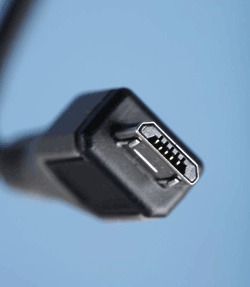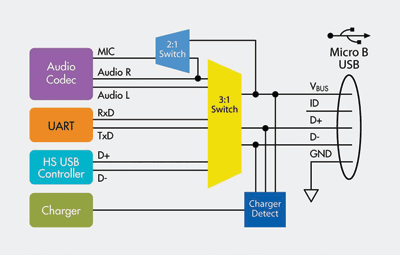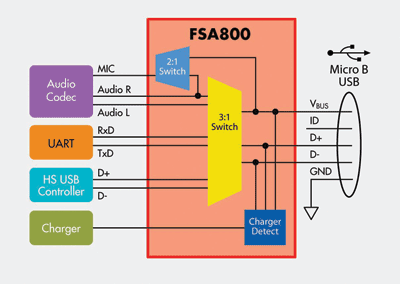Converging your cell phone to one standard interface
A single interface can enable many benefits for all from convenience to environmental impact to cost
BY PETER CHADBOURNE
Fairchild Semiconductor
South Portland, ME
http://www.fairchildsemi.com
Interfacing to a cell phone, for data, music, or charging is a regular need for most people. Having to juggle a variety of cables and find room on the phone for all the interfaces can be a costly puzzle for designers to solve.
Convergence to a single interface on mobile devices is now possible due to the work of governments and standards bodies. A single interface can enable many benefits for all, from convenience to environmental impact to cost.
Trends and drivers
Many factors are driving the move to a single interface on mobile devices. These factors include reduced height, reduced width, reuse of wall chargers, and integration.
Since technology often drives to find ways to make things smaller, the size of an interface can be very important in designing a cell phone. Many people would like the cell phone to be as small as possible so they can put the phone in their pockets or purses and have it be comfortable and not noticed. The size of the connectors can have impact in multiple ways:
If multiple connectors are used, such as an audio jack, power jack, and a proprietary data interface, these interfaces all together take up a lot of board space, as well as peripheral space on the case that forces the phone to be larger and heavier. Even if these functions are combined onto a single proprietary interface with dedicated lines for each, the width of the interface can have an impact on the size of the phone.
Cell phone designs typically drive toward as low a height as possible. This is especially a need in flip phones and slides, as the two segments of the cell phone combined need to be slim, so each segment alone must be very low in height. Any connector used for this must take height into consideration.
With a trend for manufacturers to drive toward lower cost and size, many manufacturers are also searching for ways to decrease component count, allowing for inherently smaller board space, lower power, and lower cost. This measure drives integration and the combining of functions where possible.
The advent of 3G phones also brought battery life issues along with 3G’s nice benefits. Initially, a 3G Smartphone’s battery life was noticeably shorter than previous generations. This led manufacturers to find ways to decrease power in the other parts of the phone to compensate for the shorter battery life. One method of assisting in the power reduction is the integration of connectors to be able to turn unused portions off, instead of having to keep all interfaces powered, while circuitry runs to sense when an accessory is attached.
Reuse is also a strong driver toward a common interface in phones. People buy new phones at different rates around the world, as often as every 6 to 9 months in some areas. This causes a major issue of disposing of not only the cell phone, but also the charger and other accessories every time a new cell phone is purchased.
If a phone has a proprietary interface (and especially if that is different across models in a single vendor), then new accessories must be purchased each time with a new phone. In this case, a charger is potentially disposed in a landfill every time a phone is replaced.
To combat this, governments and forums have developed guidelines to eliminate much of this waste. China, through YD/T 1591-2006 “Technical Requirements and Test Method of Charger and Interface for Mobile Telecommunication Terminal Equipment,” created a requirement that cell phones must be charged from a USB charger.
Other countries and bodies around the world have also begun standardizing toward a single charger. In 2009, the Open Mobile Terminal Platform (OMTP) forum published the recommendation “Common Charging and Local Data Connectivity” to propose a single interface for data transfer and charging, namely the micro-USB interface (see Fig. 1 ). In June 2009, the European Union signed memoranda of understandings with several major cell phone makers and chipset providers to have all phones sold in the EU to support charging and data transfer through a micro-USB interface as well.
Although the trends discussed in this section are focused on cell phones, they also apply to many different portable devices, as application markets converge. Other portable devices these trends apply to include MP3 players, personal media players (PMPs), and GPS devices. These devices all use data, audio, and power interfaces.
A solution for a single standard interface
Since, historically, manufacturers of mobile devices have had their own proprietary interfaces for different accessory interfaces, the question becomes what connector becomes the standard across all devices.
Criteria that drive the choice of connectors include the following:
Size . The connector must be small, minimizing impact to the portable device size and layout.
Flexibility . The connector must be able to use with a variety of accessories.
Manufacturability . The connector must be easy to assembly into the phone.
Robustness . The connector must be able to withstand the products lifetime on insertions without damaging the board or causing signal integrity issues.
Cost . All products drive toward a low-cost component, which with standardizing to a common connector, volume will help drive the cost lower.

Fig. 1. The Micro-B USB plug is used with many mobile devices.
With the USB interface widely prevalent, it became an obvious choice for a common connector. The USB developers group initially created the Mini-B USB connector, which can now be found on many mobile devices. More recently, with the assistance of many mobile device manufacturers, the Micro-B USB connector (at approximately half the height of the Mini-B connector) has been created and is now being incorporated into mobile devices.
Benefits
There are many benefits to a single interface, largely meeting the trends and issues discussed previously. If a common interface is used for cell phones, then manufacturers do not need to supply chargers with every cell phone, leading to significantly less waste in landfills with cell phones turning over every 6 to 24 months around the world. This additionally saves money for manufacturers and consumers.
Standardization makes it easier for third parties to provide accessories, and thus more selection and less cost for users, as well as the possibility for more performance options, such as headphone quality.
Standardization speeds development time as the interfaces are already defined and debugged. The USB data interface and the USB Dedicated Charger are already defined by USB and are widely used, reducing risk and development time.
For every extra interface on the cell phone, additional cost mounts for the connector itself, board space, assembly, and testing. Converging to a single interface limits this cost. Additional benefits of a single interface include less testing, smaller space, and possible higher reliability due to fewer components having issues.
What needs to happen
To converge all the external connection functionality onto a single USB interface, several problems need to be solved, including routing audio over the same interface as data, detecting what external accessories are connected, maintaining high performance for all devices, and keeping power low.

Fig. 2. With many accessories to be attached on a single port, there must also be a way to distinguish between the different functions attached.
Today’s main functions connected to a cell phone are audio, USB, UART (programming and debug), and charging. All of these accessory functions can be routed to the appropriate ICs within the cell phone using a high-performance multimedia switch (see Fig. 2 ). This switch should provide specific ports for each function, optimizing each port for the functions needs, including low series resistance, low THD for the audio port, and low capacitance on the USB port.
With many accessories to be attached on a single port, there must also be a way to distinguish between the different functions attached. This can be accomplished by monitoring all the signals on the port to distinguish one accessory from another.
As an example, the FSA800 single multimedia switch from Fairchild Semiconductor integrates a high-performance 3:1 analog switch to balance the needs of high-performance audio, HS USB 2.0 eye compliance, and availability of a 3:1 switch (see Fig. 3 ). It also provides a USB Dedicated Charger detection to allow phones to charge at a higher rate, as opposed to charging off a standard USB port on a computer.
Another function required for the audio interface is the ability to route the microphone to the audio codec. This can be accomplished with the same multimedia switch, with options to route the microphone over the D+ line (with mono audio) or the VBUS line.

Fig. 3. Using a single multimedia switch to solve the convergence of connectors to a single Micro-B USB interface enables the benefits of this single interface, from convenience to environmental impact to cost.
Using the FSA800 to solve the convergence of connectors to a single Micro-B USB interface enables the benefits of this single interface: enabling benefits for all from convenience to environmental impact to cost. ■
Advertisement
Learn more about Fairchild Semiconductor





